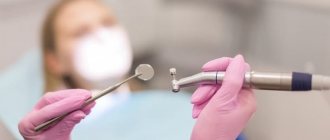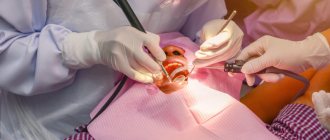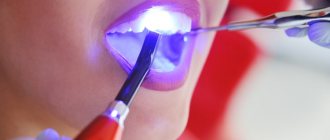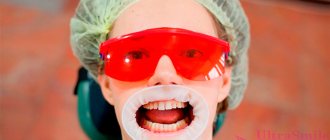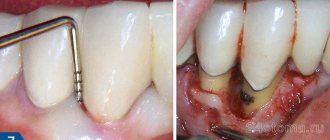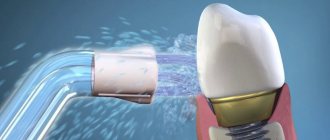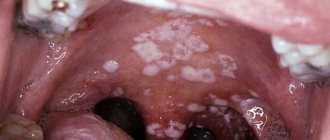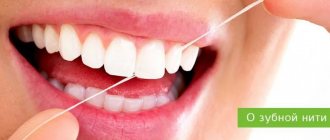Professional oral hygiene is comprehensive care aimed at preventing dental diseases. The technology allows you to get a “brilliant” result in one hour and achieve natural whiteness.
The procedure includes removing plaque using the Air Flow method and cleaning hard plaque with an ultrasonic scaler. At the final stage, fluoridation and remotherapy are performed to strengthen the enamel. In addition, the attending physician teaches the patient about home hygiene and selects care products. Professional care is highly effective, but maintaining the results is only possible if all the dentist’s instructions are followed.
What can you eat after cleansing?
After the procedure, dentists impose a number of restrictions on the patient’s eating behavior. In the first 2-3 days, foods that irritate tooth enamel are excluded from the diet: sour, hot, salty, sweet. The sensitivity of teeth after ultrasonic cleaning of stone is increased: bright tastes and temperature changes provoke pain.
Products containing dyes are prohibited. The list of what not to eat after brushing your teeth for tartar includes:
- black tea and coffee;
- colored carbonated drinks;
- chocolate;
- soy and balsamic vinegar;
- mustard and curry spices;
- red wine and grapes;
- berries (blueberries, blueberries, currants);
- red and orange vegetables;
- sweets containing dyes.
A number of products are recommended for consumption. They strengthen tooth enamel and prevent the formation of plaque and caries. Dentists advise eating dairy products in any form. Fruits and vegetables, particularly apples, reduce the amount of tartar. It is useful to drink diluted apple juice, which dissolves plaque.
Is it possible to smoke
What you should not do after having your teeth professionally cleaned by the dentist is go back to smoking cigarettes. Nicotine is a powerful colorant, just like coffee and wine. Resins, along with carcinogenic substances, settle on the hard surfaces of incisors, canines and molars, creating an ideal environment for the growth and reproduction of pathogenic microorganisms. Tobacco in general has a negative effect on bone tissue, promoting its destruction and killing beneficial bacteria.
When cleaning is carried out in the dental office, the protective film is removed from the enamel. As a result, the outer layer absorbs resinous compounds and acquires a yellowish tint after just a few days.
Also, during the procedure, the mucous membranes may be damaged. Toxins from cigarettes get inside and provoke a severe inflammatory process that can spread to the entire maxillofacial apparatus.
Smokers often suffer from bleeding, dry and loose gums. The capillaries narrow, and the gum tissue weakens, becomes dehydrated, and the oxygen concentration decreases. Because of this, caries, pulpitis, gingivitis, and periodontal disease occur. If you do not wait for healing and smoke, infection will occur, which can subsequently lead to destruction and loss of teeth.
How many days should you follow the “white diet” after teeth whitening?
The whitening process is not completed the moment the patient gets out of the chair. The effect needs to be consolidated. For this, certain restrictions are introduced. Very strict - for 48 hours, but dentists recommend not to take risks and stick to a “transparent” diet for 2 weeks
. So you will definitely amaze others with whiteness for many months. During this time, the tooth enamel will be restored and restrictions can be removed. Although it should be remembered that uncontrolled use of products with coloring pigments will cause the shine and sparkle of the enamel to fade quite quickly. But reasonable use, on the contrary, will prolong the effect.
Contraindications
Teeth brushing in dentistry, as a medical procedure, has a number of contraindications:
- cardiac arrhythmia;
- colds and infectious diseases;
- diabetes;
- pregnancy;
- HIV, AIDS, hepatitis;
- increased sensitivity of teeth or inflammation of gums;
- destruction of enamel;
- childhood and adolescence.
The procedure for cleaning teeth from foreign substances, according to generally accepted standards, is carried out as follows:
- After a thorough examination of the oral cavity, the dentist identifies problem areas in the oral cavity.
- Cleans tartar using a special tool - an ultrasonic scaler. Since tooth enamel is harder than tartar, under the influence of ultrasound
- the stone collapses, but the tooth remains undamaged. Injury to the gums is minimal. For maximum patient comfort, doctors can use anesthesia in the form of special gels or sprays.
- Then pigment spots from tobacco, coffee and other products with a high dye content are removed. They can only be removed using a special device - Air Flow.
- It works by using pressure to push out abrasive materials to effectively clean the surface of your teeth.
- Fluoridation. This makes the enamel harder.
- At the final stage, the surface is polished with rubber brushes using a special paste.
In total, a complete cleaning cycle can take from 20 to 60 minutes.
Red wine
Red wine contains tannins and chromogens that stain teeth. And the coloring effect of polyphenols, plant pigments, only enhances the effect.
Startsmile tip:
Red wine can always be replaced with white or rose, which, by the way, the French love very much. Or use a good whitening paste after drinking from the line of proven home whitening products Blanx, Global White and.
Is it possible to drink after having a filling installed?
At the appointment, patients always ask whether they can drink tea or other drinks after treatment. In this case, the same recommendations apply as for eating - it all depends on the technology. But there are also additional restrictions. Drinking drinks is not recommended until the anesthesia effect has completely subsided.
This is due to the possibility of injury to the mucous membrane by too hot a liquid, because sensitivity is reduced. It is very difficult to say exactly how long you can drink. In this case, everything depends on the effectiveness of the painkiller, its duration of action, dosage and individual reaction of the body.
What else
Recommendations after teeth whitening:
- Refrain from eating
for
2 hours
, give your body a chance to recover - Avoid cold and hot
. After dental procedures, sensitivity increases. Warm food will help avoid discomfort. - For some time after the procedure, you should brush your teeth after every meal.
- Dental floss
helps remove food debris that, when decomposed, can cause tooth decay and damage enamel. - Do not use whitening
toothpaste until sensitivity returns to normal. Then it can be used to maintain the effect 1-2 times a week. - If you don't have the strength to give up caffeine, use a straw.
But it is better not to drink it after bleaching for at least 48 hours.
The result of whitening in ROOTT dentistry
After installing a temporary filling
A temporary filling is necessary for multi-stage treatment, which involves access to the cavity after several days or weeks. Therefore, the strength and aesthetic requirements for such materials are low. But in any case, you must adhere to the specialist’s recommendations, otherwise the filling will fall out, pathogenic microbes will enter the cavity and the procedure will have to be repeated.
After installation of a temporary filling, patients are interested in the ability to eat and drink. These points need to be considered.
Is it possible to drink
If a regular cement filling was used, you can drink after 2-3 hours. If the cavity is closed with photopolymer, immediately after installation is completed. But the point here is not about strength, but more about anesthesia. When exposed to it, sensitivity is minimal, so the patient may not feel the temperature of the drink and injure the mucous membrane. Therefore, you need to drink very carefully, avoid too cold or too hot, and it is better to do this after the painkiller has worn off.
Is it possible to eat
The specialist’s answer depends on the material
. The use of a cement filling involves the same restriction as in drinking: from 2 to 3 hours. With photopolymer, it is absent, but it is not recommended to load the tooth until it has completely hardened, so you will have to abstain from hard foods for at least a day.
Is it possible to experience discomfort after treatment?
After the procedure, slight discomfort is present for 14 days - this is normal.
. During this period, it is necessary to eliminate as much as possible the influence of factors that provoke unpleasant sensations - hot and cold foods, sour, spicy and sweet foods. You also need to avoid excessive stress and carry out hygiene procedures with caution.
But if pain occurs after this period has expired, this is a reason to consult a doctor. There are many reasons for this phenomenon, and only a specialist can accurately identify a specific one.
Recommendations
Immediately after installation, you must refrain from drinking and eating for the time recommended by the dentist until the final effect of the pain medication. After this period, you should not eat foods that are too hot or too cold, as they may affect the strength properties of the material.
The load should be moderate. It is advisable to try not to chew on this side of the jaw during the day, since the filling may become loose if it does not harden sufficiently.
In addition to traditional questions about food and drink, dental visitors are also interested in additional questions.
Is it possible to drink alcohol
In fact, alcohol does not have any special effect, which means that theoretically it can be consumed. But the point here is completely different. In most cases, filling is performed under anesthesia, and it and alcohol are incompatible. Therefore, experts recommend abstaining from alcohol for at least a day.
The same can be answered to the question “can I drink beer?” After 24 hours, yes, you can. Beer does not contain coloring enzymes and fillings do not change color under its influence.
Is it possible to smoke after installation?
After the filling procedure, you can smoke approximately 2-3 hours later.
. Tobacco smoke does not affect the color of the filling, unless it concerns plastic-based compounds. They are rarely used due to their fragility, but when using such a composition, smoking immediately after the procedure will cause its darkening. Ideally, dentists recommend giving up cigarettes for at least a day, if possible.
Contraindications to professional teeth cleaning
There are many positive effects from the procedure, but there are also negative aspects and associated contraindications for use. These contraindications do not apply to every patient, but only in exceptional cases when the patient has individual distinctive characteristics of the gums or teeth.
- Sensitivity of the gums and enamel - the procedure can be performed, but it will be painful, which is negatively perceived by patients.
- Periodontitis and other oral pathologies are present.
- Age less than 18 years.
- Bacterial and viral diseases.
- Allergy to medications and products used in the process.
- Increased heart rate, arrhythmia.
- Dangerous infections (hepatitis, tuberculosis, AIDS or HIV).
- Multiple foci of caries.
The dentist’s duty is to ask the patient about all of the above. Even if the disease or condition is not directly related to dental matters, it influences the doctor's decision.
A dentist who values his reputation will not agree to perform a procedure even for money if it harms the patient.
What causes recurrent caries
Repeated carious lesions of tooth tissue can occur due to non-compliance with technology,
which happens rarely, or
the patient’s failure to comply with the doctor’s recommendations – which happens often
.
Due to the shrinkage of the material, which is caused by increased load on the tooth, microcracks appear between the filling and the tissue. They contain pathogenic bacteria. When they multiply, they form an acidic environment. All this contributes to the occurrence of repeated caries, which is hidden under the filling and is diagnosed only after the active development of the pathology. Therefore, it is very important not to violate the doctor’s recommendations. Also, incorrect actions can cause the filling to fall out.
